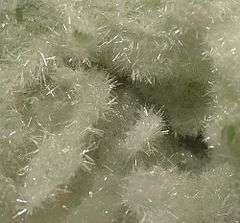Skorpionite
| Skorpionite | |
|---|---|
|
Skorpionite | |
| General | |
| Category | Phosphate mineral |
| Formula (repeating unit) | Ca3Zn2(PO4)2CO3(OH)2·H2O |
| Strunz classification | 8.DO.45 |
| Dana classification | 43.5.20. |
| Crystal system | Monoclinic |
| Crystal class |
Prismatic (2/m) H-M symbol: (2/m) |
| Space group | B2/b |
| Unit cell |
a = 19.042 Å, b = 9.309 Å c = 6.519 Å; β = 92.72°; Z = 4 |
| Identification | |
| Color | colorless |
| Crystal habit | needle-like crystals elongated parallel to [001]; bladed, sword-shaped |
| Fracture | irregullar/ uneven |
| Tenacity | brittle |
| Mohs scale hardness | 3½ |
| Luster | vitreous |
| Streak | white |
| Diaphaneity | transparent |
| Density | 3.15 g/cm3 |
| Optical properties | Biaxial (-) |
| Refractive index | nα = 1.588 nβ = 1.645 nγ = 1.646 |
| Birefringence | δ = 0.057 |
| 2V angle | 15.0° (measured) |
| References | [1][2] |
Skorpionite (IMA2005-010) is a zinc phosphate mineral with chemical formula Ca3Zn2(PO4)2CO3(OH)2·H2O, originally found in the Skorpion Mine and named after it (Rosh Pinah, Lüderitz district, ǁKaras Region, Namibia).
References
- ↑ "Skorpionite: Skorpionite mineral information and data.". mindat.org. Retrieved 2015-11-25.
- ↑ Anthony, John W.; Bideaux, Richard A.; Bladh, Kenneth W.; et al., eds. (1990–2013). "Skorpionite" (PDF). Handbook of Mineralogy. Chantilly, VA: Mineralogical Society of America.
This article is issued from Wikipedia - version of the 11/21/2016. The text is available under the Creative Commons Attribution/Share Alike but additional terms may apply for the media files.
